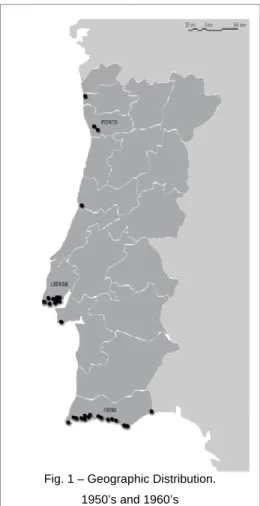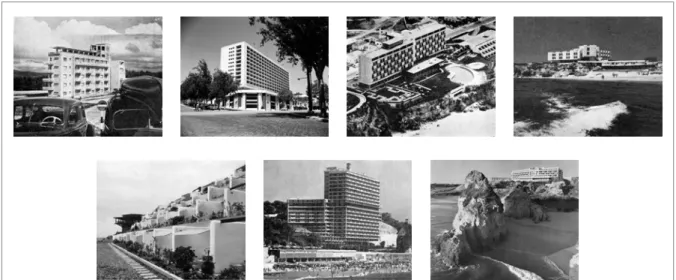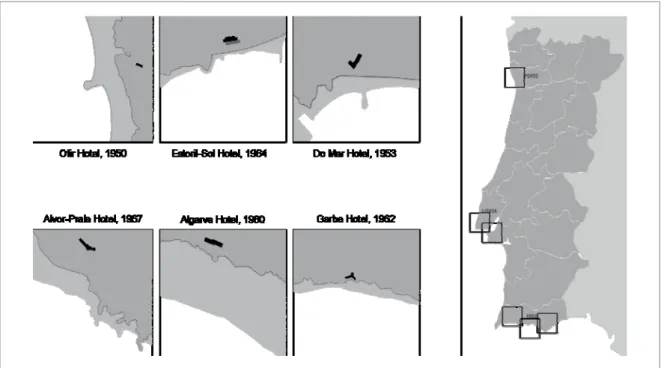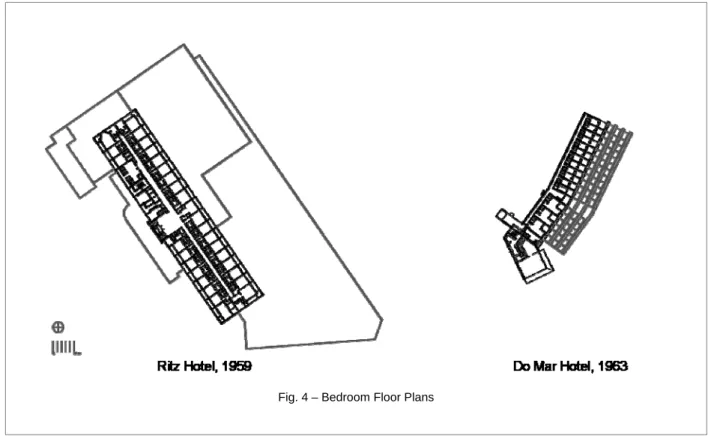The First Moderns in Portugal. Hotels overlooking the sea
Madalena Cunha Matos, Patrícia Santos Pedrosa, Marta Sequeira and Raquel Costa Rega
Faculty of Architecture – Technical University of Lisbon
Rua Sá Nogueira Pólo Universitário - Alto da Ajuda 1349 – 055 Lisbon, Portugal Phone +351 213615046 / +351 213615823
ahp@fa.utl.pt
1. Contextualizing
In the beginning of the 20th century Portugal was in what concerns tourism, between two distant realities. On one hand, tourism was pointed out as a way of solving economical problems. “Tourism was not only joy, movement, beauty and life but it was also health and wealth”, wrote the eminent 1st Republic politician Magalhães Lima. On the other hand, the real condition of the country reflected the fact that Portugal had still a long way to go before becoming a well-known tourist destination. According to reports at that time, the quality of the hotels was poor, reflecting the incapacity of offering good lodging conditions as well as a total absence of a national touristic project (PINA,1988:25). This flagrant incapacity acted as a restraint to the development of the Portuguese touristic activity in the three first decades of the 20th century.
As a consequence, the introduction of the tourism industry in Portugal was, when compared to other European countries, considerably delayed. António de Oliveira Salazar (1889-1970) was the main figure of the political regime that since the 1920’s up to 1974, forced the country into a parallel world. According to Salazar «with tourism there’s a bit of the nation’s soul that is sold out» so he absolutely tried to avoid it (PINA, 1988:161). Tourism would promote the contact between different people and different ways of life, putting at risk the required isolation of the country that so well suited the dictatorship regime.
From the beginning of the 1960’s this situation starts to change. The engine for this change was the economy. This small country, having to defray the colonial wars, finds in the touristic activity as well as in the money sent by its emigrants, two ways of obtaining some «economical relief» (BARRETO,1996:36).
Due to the difficulties concerning the implementation of a national touristic project, the main tourist attractions are scattered and rely on two major ingredients: beaches and spas. The rising popularity of Estoril beach, near Lisbon, begins in the 1910’s. In 1932 it was already attracting 2500 foreigners per year. One of its success factors was in the fact that it could offer, in a single place, three different types of activities, namely beaches, spas and casinos (PINA,1988:35).
A new tourist site blooms in 1917 with the reportsabout the supposed vision of the Virgin Mary in an open field near to the village of Fátima. This event transforms this place into a centre of devoted pilgrimage for the Portuguese catholic community – later to encompass a global international catholic community. In 1928, religious tourism acquires more and more relevance and the renascence Basilica is built, designed by Gerard Van Krieken. Twelve years later, an Urban Plan for this area is carried out (PINA,1988:36).
During the first half of the century, the increasing demand for beaches as opposition to spas was noticeable. In some beach resorts such as Figueira da Foz, Estoril, Espinho and Póvoa do Varzim the opening of casinos contributed to an enlarged entertainment offer (PINA, 1988:45).
Up to the late 1930’s roads were modest and the almost insurmountable Monchique mounts provided a natural barrier that kept the Algarve in a sort of a geographic divorce from the rest of the national territory. Only later on, in 1965 the Faro airport was opened to the public. In the 1950’s, but mainly in the 1960’s, the mobilization of the country took place. Both professionals and simple citizens were called out for the «battle of tourism» (PINA, 1988:167). It was the turning point for the beginning of the great development in the tourism and real estate industries that would irreversibly come to mark the Algarve coast line.
2. Geographic Distribution
In this period – the 1950’s and the 1960’s – the increasing number of hotels in Portugal is quite evident, reaching a figure of 2521. From all hotels built at this time, in continental territory, 29 were considered in this study2.
All of these hotels are located on the Portuguese coast line. Although some may be scattered up the North coast, in Ofir, Oporto and Figueira da Foz, the majority of the cases’ sites are in Lisbon or its surroundings and mainly on the Algarve Coast (fig. 1). The first cases appear at the very beginning of the 1950’s, on the North coast. The hotels built in the second half of the decade are mostly located in the greater Lisbon area, with a single exception in the Algarve. In the 60’s, hotel architecture finally explodes in the Algarve area.
Fig. 1 – Geographic Distribution. 1950’s and 1960’s
Simultaneously, some isolated cases appear in the capital’s area and its immediate surroundings.
While hostels are still the type of lodging that offers the largest number of beds in the Portuguese territory, in Lisbon, as well as in the Algarve, by the end of the 1960’s, hotels, especially the luxury3 ones, are in greater demand. It is evident why these became the most developed areas of tourism urban planning in the country at the time. In what concerns the government initiatives in the 1960’s, regarding the development of the Algarve tourism urban planning, important strategies were determined. Two plans were implemented, the Tourism Recovery Plan and the Algarve Regional Urban Plan. And three studies were carried out, the Basis for Tourism Development in the Algarve, Urban Study of Towns and Villages on the Coast of the Algarve and the Study for the Landscape Planning of the Territory.
In Lisbon, an outbreak of hotels happens to respond to the increasing amount of tourists. At this stage, airlines had some responsibility in this phenomenon. They had their refuelling stopovers, after the Atlantic crossover, in Lisbon airport due to the reduced autonomy of airplanes at the time. Lisbon, the “dock of Europe” becomes now its “airport gate”. In the capital, the airport’s strategic placement for international convenience promotes the booming of hotels. In opposition, in the Algarve the airport was inaugurated in 1965, as consequence of the hotel outbreak that preceded it. In these two decades, the main flux of tourists did not come by air but by land, and it was an important boost to the development of roads and railroads that served the Algarve4.
3.
Case-studies
Of the 29 case-studies on which we based our analysis, some hotels were reconversions of existing buildings, such as the Infante Sagres Hotel (in Oporto), the Palace of Seteais Hotel (in Sintra), and the Fortress of Guincho Hotel (in Cascais) – an old housing block building, a palace, and a reconstructed fortress, in that order. However, 26 were purposely built from scratch and are a valuable testimony of the innovative hotel architecture in Portugal. From this set, seven are very good examples of the morphologic structures that appeared in this period and the evolution that occurred (Fig. 2).
The first one, the Ofir Hotel, was designed by Alfredo Ângelo de Magalhães. It was built in 1950 by the Ofir beach on the North coast of Portugal. This hotel unit was placed on an isolated area of pinewood trees simultaneously by the sea and by the river. Therefore, it served two different types of beach; it offered only 35 bedrooms. The Ritz Hotel by Porfírio Pardal Monteiro5 was built in 1959 and became the first big international hotel in Lisbon. This building was placed in a privileged area in the centre of the capital and had to offer 300 bedrooms. The Algarve Hotel by Raul Francisco Tojal6 was inaugurated in 1960 on the nation’s South coast in Portimão. This hotel unit took up about 12 thousand square meters and was placed on the cliff of the Praia da Rocha. This hotel offered a total of 209 bedrooms. The Garbe Hotel, also on the South coast of the country was designed by Jorge Ferreira Chaves and Frederico Santana and it opened its doors to the public in 1962. It was also placed on a cliff. It offered 60 bedrooms over the Armação de Pêra beach. The Do Mar Hotel by Conceição Silva was built on the fisherman’s small town of Sesimbra near Lisbon. It was opened to the public in 1963. It was placed on a sharp slope over the beach and originally had 65 bedrooms. The Estoril-Sol Hotel by the architect Raul Tojal was inaugurated in 1965, in Estoril, also in the surrounding area of Lisbon. The building was placed by the coastline road, looking over the sea. The Alvor-Praia Hotel, designed by Alberto Cruz7 opened in 1967 with 215 bedrooms. It was built on the bay of Lagos, by the Praia dos Três Irmãos, again a South coast beach. The Ritz Hotel is by far the most urban example of the cases studied. It is located in the centre of the capital’s urban territory. It opens precedence for a new understanding of hotel architecture, one that follows the needs for a modern way of life and the new found parameters of comfort. It responds to the new
image of tourism following the trend of other capitals. At last Lisbon had a truly international hotel designed according to the rules of a strictly modern architecture. It finally had a hotel with the dimensions worthy of a European capital city.
The Ritz is a primordial example in this aspect. However the remaining case studies are still crucial examples when it comes to thinking about the development in architecture at a national scale. The Ritz founded Modern Architecture in terms of hotel architecture in the capital, in a city where the existence of some buildings had already proved that modern ways of life were finally in vogue. The hotels in Ofir, Praia da Rocha, Armação de Pêra, Sesimbra, Estoril and Praia dos Três Irmãos, played an absolutely remarkable part. On one hand each hotel played the role of a founding agent of place (as opposed to space) claiming and conquering virgin land. On the other hand, they had a role of spreading the modern spirit throughout the country. An overall view of the site plans of each case study allows verifying a proximity relationship to the coastline (fig. 3). They are all placed exactly where the line ends, by the beach.
Looking at the photographs taken at the time of each hotel inauguration, we can verify that the beach and the ocean itself have a leading role in their place setting (fig. 2). In some cases as it is shown in the photos of the Ofir Hotel and the Do Mar Hotel, emphasis is placed on the view from the hotel to the sea. In most of the cases, the iconic photos of the
hotels show us an impossible and improbable sight. The view is no longer from the hotel to the sea, but from the sea to the hotel. The great proximity of the objects to the coast is highlighted through the rhetorical mechanism of positioning the photographic point of view. These same photos show that these buildings played a special role in the villages and places where they were set in. At the beginning they might have been totally isolated. But they quickly constituted a first step in the process of urbanizing these places. Therefore, they contributed towards the spreading of modern architecture into the distant places of Ofir, Praia da Rocha, Armação de Pêra, Sesimbra and Praia dos Três Irmãos that were mostly unpopulated and certainly empty of such modern architecture.
All of these hotel’s project briefs were thought out by the architects themselves. At the time the architect was thought of as cultivated man. A man who would have travelled abroad and would have a clearer idea than a building investor, of what a contemporary hotel should be. The social areas become fundamental, and their spaces are thought out in a way that a series of new activities may occur. Casinos, nightclubs, swimming pools and golf courses, unusual spaces up until that time, became more popular. In urban hotels like the Ritz, the corridor is located in the middle of two strips of bedrooms. One strip has a privileged view and the other one not so much. With the exception of the Alvor-Praia Hotel, the typical bedroom floor plan of these coastal hotels has a single strip of bedrooms with a view over the sea, usually facing South. With only one exception, the bathrooms are next to the
corridor, so that the facade can have a large window, connecting the bedroom with the veranda. The proportion of the bedrooms layout changes with time. They start off by having a small depth and a large width. In the end, they change in order to maximize the number of rooms with a sea view. The verandas persist in all of them. Some are as large as the bedroom itself so that guests can spend in it a significant part of their holidays enjoying the sights and the sun8.
Using the slab or miming the topography of the sites (MATOS, 2004:178), these coastal hotels convey the revolutionary paradigms of international architecture in the territory where they where placed.
4. Final notes on the present and the future
Half a century later, the territorial and iconic importance of these hotels has been deeply modified. The development of the tourist areas, whose modernization, in many cases, they inaugurated, took proportions that would have been difficult to predict. Two parallel factors of acculturation acted on them. They were built as landmarks. They were placed in an isolated territory and nowadays they are involved by a mass of construction, with no personality, no urban or architectural character. The second factor is their own updates. Enlargements, renewals, and demolishment made them lose coherence and in many cases, made them unrecognizable.
Given the architectonic quality that some still have, it would be interesting to see them as historical architectural objects. Perhaps the creation of a Portuguese modern hotel route (from the 1950’s to the 1960’s), safeguarding their existence as cultural heritage, could instigate their importance and defend them from the permanent pressure. After all, there is nowadays a place for many forms of tourism, the cultural and architectonic tourism being one of them.
Notes
1 – Though the Portuguese National Institute of Statistics (INE) appeared in 1935, it only starts keeping data referring to tourism in Portugal at this time. Regarding the number of existing hotels it has data starting in 1962; from this date to 1969 the numbers show a total of 192 to 252 in 7 years which represents a growth of 31%. While the number of overnights goes up in the 1970’s this doesn’t mean that the number of hotels has increased. It is only during the 1980’s that a new booming will happen. Source: INE.
2 – These hotels where selected based in a systematic analysis of architectural magazines of those days and in many field trips carried out.
3 – In the areas of Lisbon, Algarve and Madeira, mainly in the last two areas, the major part of the hotel’s capacity is for the upper class. The number of beds offered by hotels, luxury hostels and 1st class hostels have respectively 51,9%, 69,7% and 78,5% of the total capacity of those regions. In Lisbon, Algarve and Madeira, the major part of the tourism lodging is covered by hotels. In Oporto and remaining areas hostels offer the largest
number of tourism lodging. Relatório de Execução do III Plano de Fomento – Metrópole – 1968. Secretariado Técnico da Presidência do Conselho, 1970, p. 225 (Marino Coelho,” Administração Pública do Turismo em Portugal”, 1992, p.295).
4 – In 1969, 487 863 tourists land on portuguese ground, 46 734 come in by sea (416 095 of them are stopovers), 1 834 676 come in by land. Source: INE.
5 – In collaboration with Jorge Ferreira Chaves, Frederico Sant’Ana, Anselmo Fernandez, António Pardal Monteiro and Eduardo Medeiros.
6 – In collaboration with Manuel Óscar Baptista Coutinho de Carvalho and António Brito on the architecture project and with Eduardo Anahory on the interior design project.
7 – In collaboration with F. Pereira.
8 – The areas of the verandas are: Ofir Hotel – 3,80 m2, Algarve Hotel – 7,50 m2, Garbe Hotel – 3,70 m2, Do Mar Hotel – 9,30 m2, Estoril-Sol Hotel 7,00 m2, Alvor-Praia Hotel 7,64 m2.
The authors are grateful for the collaboration of the architectural trainee Susana Cirilo.
References
Associação dos Arquitectos Portugueses. Arquitectura Popular em Portugal. Lisboa: Associação dos Arquitectos Portugueses, 1980 (2.ª ed.) [1961]
Barreto, António. "Três décadas de mudança social" in António Barreto. A Situação Social em Portugal, 1960-1995. Lisboa: Instituto de Ciências Sociais Universidade de Lisboa, 1996, pp. 35-60
Coelho, Marino. Administração Pública do Turismo em Portugal. Dissertação de Doutoramento em Ciências Sociais. [Lisboa: Instituto Superior de Ciências Sociais e Políticas], 1992
Matos, Madalena Cunha (2003). “Face ao Oceano. Arquitectura Portuguesa nos hotéis atlânticos dos anos cinquenta e sessenta” in Fundación Docomomo Ibérico (org.), “Arquitectura Moderna y turismo: 1925-1965” Actas IV Congresso Docomomo Ibérico, Valência.



